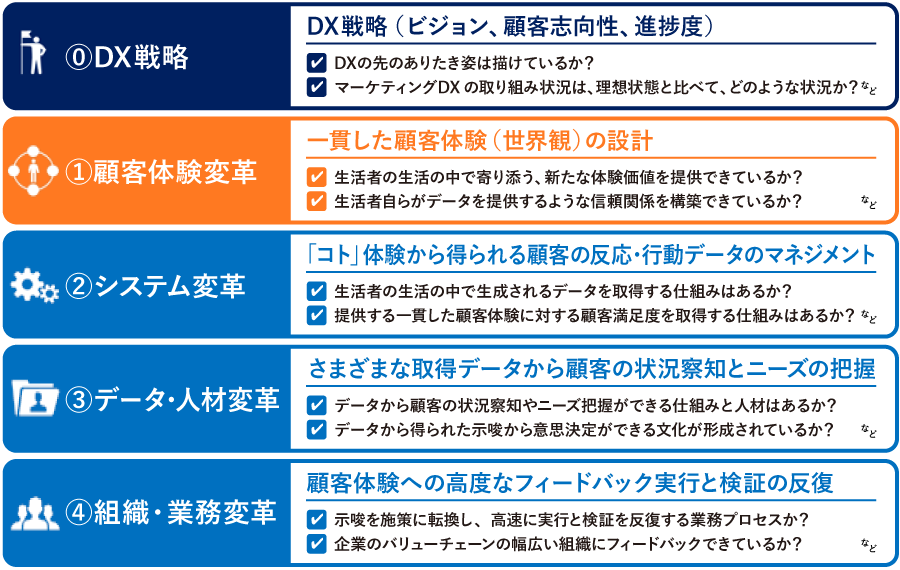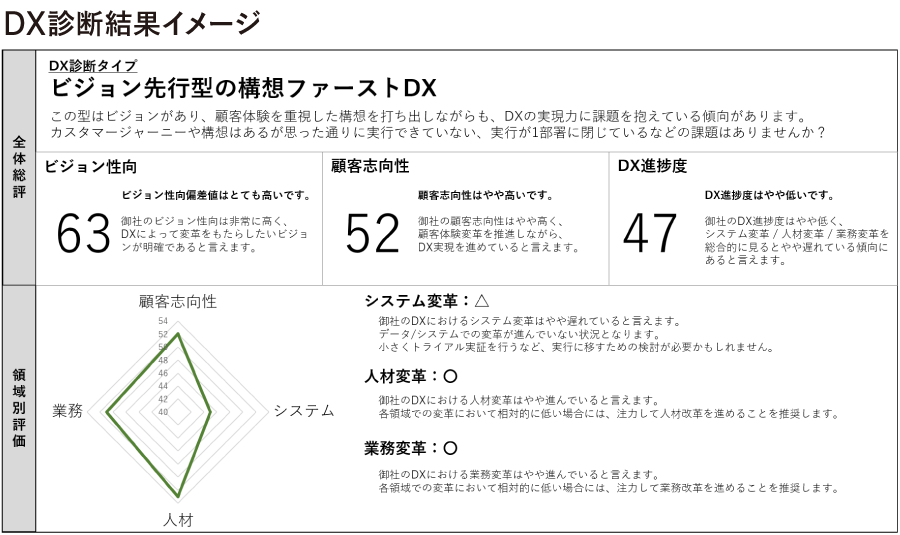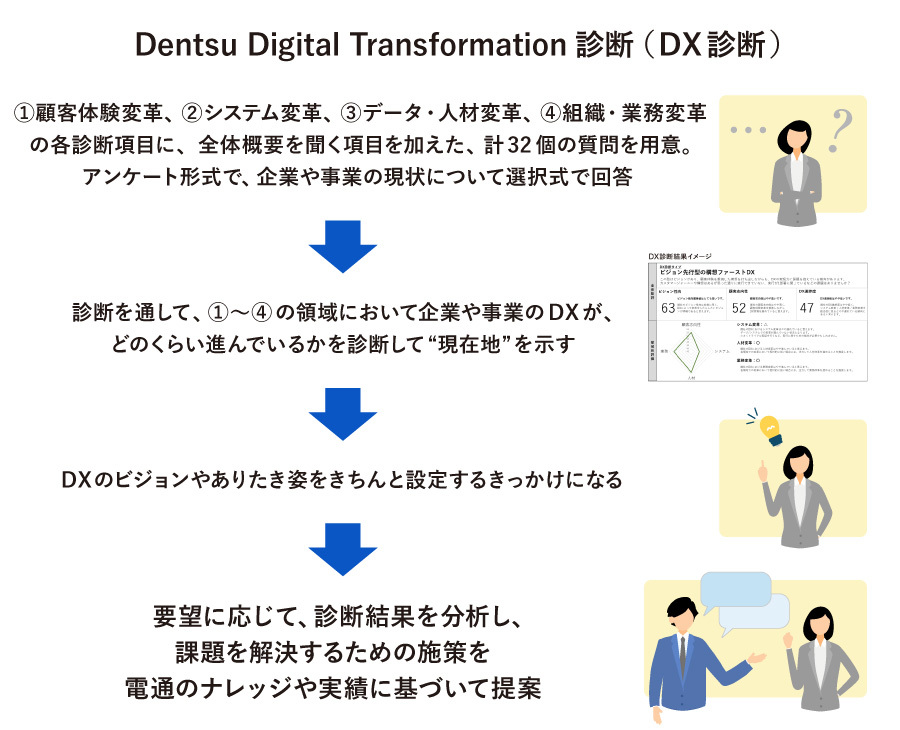Customer touchpoints across various channels are becoming digital, and the use of data through 'one-to-one communication' is expanding. Leveraging its accumulated expertise in people-centric marketing, Dentsu Inc. defines and supports the digital transformation (DX) of clients' customer touchpoint domains as 'Marketing DX.'
As one action, Dentsu Inc. released the "Dentsu Digital Transformation Diagnosis" (hereafter DX Diagnosis) in September 2020. This scores a company's DX challenges, indicating its "current position" in terms of how far its DX for the company or business has progressed. In addition to presenting the diagnosis results, solutions for addressing the challenges are also proposed upon request.
This article introduces the case of Rohto Pharmaceutical, which underwent the DX Diagnostic. Akiko Kosugi from the company's DX Strategy Design Division was interviewed by Akihiko Miura from Dentsu Inc.'s Business Transformation Division. We hear about the challenges and insights revealed through the diagnostic process.
The diagnostic process helped us recognize our challenges. It allowed us to consider our company's DX "current status" from a new perspective.
Miura: Since its release, our "DX Diagnosis" has received inquiries from over 60 companies. The response has been overwhelming, reaffirming to us the growing necessity of DX across various industries. Why did your company decide to undergo the DX Diagnosis?
Kosugi: Rohto Pharmaceutical began in 1899 with the stomach medicine "Ikatsu," and has since manufactured OTC medicines like eye drops and skin medications, skincare cosmetics, and food products. In recent years, we've expanded into diverse businesses like regenerative medicine and food services, aiming to help each person live vibrantly in body and mind. We believe DX is an essential strategy not only for efficiency but also to better understand customers and provide new products, services, and value tailored to each individual.
At the time of the DX Diagnosis, I was part of the digital team within the marketing department. There, I had frequent opportunities to learn about DX and felt firsthand the rapid pace of technological evolution. Simultaneously, I was anxious about the gap between our company's situation and this wave of change, wondering, "Can our company keep up with this reform?" Amidst this, the DX Diagnosis was introduced to me. Despite a premonition that "we probably won't score well," I decided to take it.
Miura: I believe everyone who feels even vaguely that their company's business needs to undergo DX should try the "DX Diagnosis" at least once. It's questionnaire-based, featuring 32 questions across four diagnostic areas: ① Customer Experience Transformation, ② System Transformation, ③ Data & Talent Transformation, and ④ Organizational & Operational Transformation, plus an overall overview section. Respondents answer multiple-choice questions about their company's and business's current state.

Part of the diagnostic items. To analyze the client's DX from multiple angles, we prepared questions comprising a total of 32 items across three perspectives and four domains. The client's responses are used to quantify and diagnose DX challenges.
Kosugi: Undergoing the diagnosis made us aware of our shortcomings even while answering the questionnaire. For instance, when we decided to advance DX company-wide, we realized the necessity of top-level commitment and external communication. We gained many such insights. Interestingly, during the diagnosis, a new department called the "DX Strategy Design Headquarters" was established to drive company-wide DX, and I was transferred there. The timing couldn't have been better.
Miura: I also felt that your company was precisely at the stage of "moving forward with DX," which is why you had such a strong sense of the challenges. At that moment, I wanted to provide an understanding and discovery of your company's "current position" within DX.
When we received your responses, it was clear that Mr. Kosugi had thoroughly reviewed and considered even the smallest details. What specific process did you follow to answer the questionnaire used for the diagnosis?
Kosugi: I held multiple discussions with the current leader of the Marketing & Communications Department. We each thought about the questions, then coordinated our responses... repeating this process until we finalized the answers. Answering the "DX Diagnosis" questionnaire naturally forces you to confront your own situation head-on. Since the questionnaire breaks down into multiple domains, it allowed us to consider how our DX initiatives were progressing from diverse perspectives, including angles we hadn't previously considered. I truly believe that experience was invaluable.
Among the questions, defining "customer" was particularly challenging. However, for companies that can genuinely consider "customer experience transformation" in their DX efforts, I felt this was an extremely effective diagnostic tool.
Miura: Thank you. I believe these insights were possible precisely because Mr. Kosugi and everyone at Rohto Pharmaceutical engaged so earnestly. We see significant value in the very process of undergoing our DX diagnosis. The process itself—struggling, thinking, and debating based on our systematically organized diagnostic questionnaire, built on our expertise—is a major value we provide.
Diagnostic findings that revealed the importance of "What DX means for our company?"
Miura: Our "DX Diagnosis" was developed leveraging insights from people-centric marketing, which is precisely its unique strength. Could you share what stood out most when reviewing the actual results, or the areas where you felt the strongest sense of challenge?
Kosugi: In the overall summary of the diagnostic results, the current state of our marketing DX—still very much in the trial-and-error phase—was described as "wild intuition." While I expected this, it was still quite shocking. Among the findings, the "definition" aspect stood out as a particularly strong challenge. The questionnaire starts with numerous questions about definitions—not just customer-related ones, but all kinds of definitions. Our results showed we are especially weak in this area.
While some departments were proactively advancing DX, we recognized a major challenge: at the company-wide level, there was no clear definition of "What is Rohto Pharmaceutical's DX?" or "Where should we be heading?" There was no defined destination or key areas where we needed to focus our people, power, and resources.
As the "Wild Instinct Type" diagnosis aptly describes, some departments are independently advancing system reforms or tool implementations. However, when considering the company as a whole, the lack of a defined goal prevents the consolidation of efforts and hinders the generation of momentum.
Miura: For our readers, "Wild Instinct Type" refers to companies that, as the name suggests, tend to lack a clearly defined corporate vision or desired future state. In past cases, when we conducted diagnostics and proposed solutions, having a well-defined "desired future state" enabled us to drive initiatives much more effectively. That's why we place particular emphasis on questions related to vision.
Kosugi: I see. As someone directly involved, I was quite shocked by the DX Diagnosis results, but at the same time, it felt like a vague sense of urgency about needing to move forward was finally articulated clearly.
Based on the diagnostic results, Dentsu Inc. explained the common challenges associated with that type and the corresponding recommended solutions, drawing from their extensive knowledge and proven track record.
Miura: On top of that , while making our proposals, we also listened to your specific operational concerns, right?
Kosugi: Our company has many departments, and we were struggling with where to even begin... Since the DX Strategy Design Division is still small, we were feeling our way in terms of how to drive this company-wide. We especially felt the need to delve deeper into organizational and operational transformation.
Miura: We've heard similar concerns from other companies that underwent our DX diagnosis. To provide even greater value, we developed the "DX Diagnosis for Internal" ( release details here ), which delves deeper into organizational and operational transformation. Your company also underwent this diagnosis. Next time, we'd like to hear about the insights gained through this diagnosis. Stay tuned.
We have strengthened and expanded Dentsu Inc.'s DX diagnostic solutions into a series by responding to numerous inquiries. The "DX Diagnostic" introduced here is a tool that broadly visualizes corporate DX challenges. Furthermore, this year we released the "DX Diagnostic for Internal," specialized for internal organization and operations, and the "DX Diagnostic for Systems, " focused on the systems domain. If you are interested, please feel free to contact us.
[Contact Information]
Marketing DX Diagnostic Team info.dx@dentsu.co.jp












